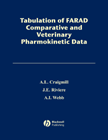|
|
|
| |
 |
|
|

|
 推薦指數:
推薦指數:





|
|
- 內容介紹
|
Tabulation of FARAD Comparative and Veterinary Pharmacokinetic DataBy: Arthur Craigmill, Jim Riviere and Alistair Webb
Publication Dates
USA: Jan 2006
Details
1952 pages,
Description
The use of therapeutic and antimicrobial agents to prevent, to control, and to eradicate disease in herd animals has without question revolutionized food animal production capacity. But how much of a good thing is too much? 20th century advances in disease diagnosis and treatment have led to 21st century concerns about the health risks posed to consumers when the animals they consume have been exposed to antimicrobials, therapeutic drugs, pesticides and other environmental contaminants. The Food Animal Residue Avoidance Databank provides the pharmacologic data that veterinarians and producers need to screen animals that have been exposed to chemicals and to ensure that dangerously contaminated tissues of food-producing animals do not enter the human food chain.
Established only twenty years ago under the auspices of the USDA, FARAD is an international venture that brings together and collates information on applications of pharmacokinetic principles to drug and chemical residue avoidance - information that previously has been spread throughout the literature. Now, the Tabulation of FARAD Comparative and Veterinary Pharmacokinetic Data brings together in a single source all the most current information on chemical residues in food animals, and provides easy access and numerous tables that offer essential pharmacokinetic data for chemicals in serum, plasma, blood, or in other matrices. This updated one-of-a-kind volume also features additional data on laboratory rodents, dogs, cats, and horses to facilitate broader interspecies extrapolations.
This easy-to-use and newly-updated publication is the essential reference on the subject and belongs in the library of veterinarians, toxicologists, pharmacologists, animal scientists, food hygienists, and regulatory personnel involved in human food safety.
TopTable of Contents
1. Approved Drugs for Food Animals
a. Tradename
b. Manufacturer
c. NADA Number
d. Generic Drug(s)
e. Species Indications
f. Disease Indications
g. Routes of Administration
h. Dose
i. Withdrawal times
2. Tolerances for Residues
a. All established tissue tolerances
b. Milk and egg tolerances
c. Action levels
d. Safe levels
e. Federal Register references
3. Pharmacokinetic Data
a. Half-lives
b. Volumes of Distribution
c. Clearance
d. Organ residues
e. Influence of disease
f. Influence of other chemicals
4. Bibliographic Citations
a. Authors
b. Title
c. Journal citation
d. Species
e. Generic chemical
5. Rapid Residue Screening Tests
a. Test Name
b. Source (Manufacturer)
c. Sensitivity
d. Drugs
6. Educational Resources
a. Title
b. Authors
c. Type (AV, Fact Sheet, etc.)
d. Species
e. Description
FARAD as a Research Tool
1. Identification of data gaps
2. Fine tuning
3. Interrelationship with minor-use program
|
|
|

